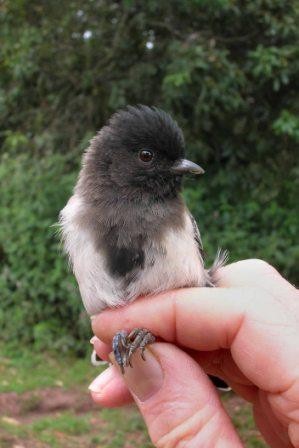|
Provisional results
At Bwindi Stripe-breasted Tits occur mainly above c. 2,000 m, at low
densities, and are associated mainly with gaps in the forest canopy. As a
result, they are more often encountered along tracks and footpaths than
under closed-canopy, perhaps giving the impression that they are more
abundant than they really are. A survey in 2002 suggested that there may be
as few as 2-4 pairs per km2; a figure
that is broadly
consistent with the number of known pairs in the vicinity of Ruhija.
The species' breeding season is longer than that of its European and
North American relatives, spanning
December to April, and occasionally also June-July. Breeding tends
to occur in the drier months of the year, suggesting that caterpillars
are more abundant at these times, or that adults are able to forage more
efficiently in drier weather. In either case, it is possible that an
increase in rainfall in the Albertine Rift, particularly during the
drier months, could disrupt the tit’s food supply, or the stimulus to
breed.
Compared with the 6-11 eggs laid by female Great Tits in
Europe, Stripe-breasted Tit clutches are small – typically 3 or 4
eggs. Despite its smaller brood sizes, and the occasional assistance
provided by
helpers, Stripe-breasted Tit chicks are usually fed at a slower rate
(per chick) than their northern counterparts.
While
individual females have been recorded laying several clutches in one
year, they tend to fledge fewer offspring per annum than their northern
relatives, suggesting that adult Stripe-breasted Tits live longer
(balancing lower productivity), or that their offspring have a better
chance of surviving their first year. One striking feature of the study
is that juveniles are often seen with their parents several months after
fledging, and may benefit from extended parental care.
Colour-ringing has enabled us to follow the fate of
individuals over several years, as the following example illustrates. 
'Female 4’
The bird shown on the right, ‘Female 4’, was first colour-ringed as a breeding adult
in January 2003, along with her mate, ‘Male 3’. Over the next 3 years they
bred together at least six times (that we know of), before Male 3
disappeared, some time after April 2006. Female 4 then found a new mate
(M51), with whom she bred at least four times.
She laid
her 10th
clutch of eggs in December 2008. Curiously, her mate provided little
help, leaving ‘4’ to rear their chicks largely unaided. She was seen
again in March 2009, building yet another nest, but disappeared shortly
after. |


